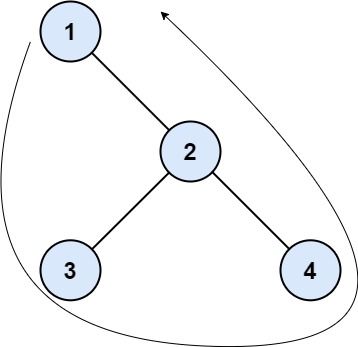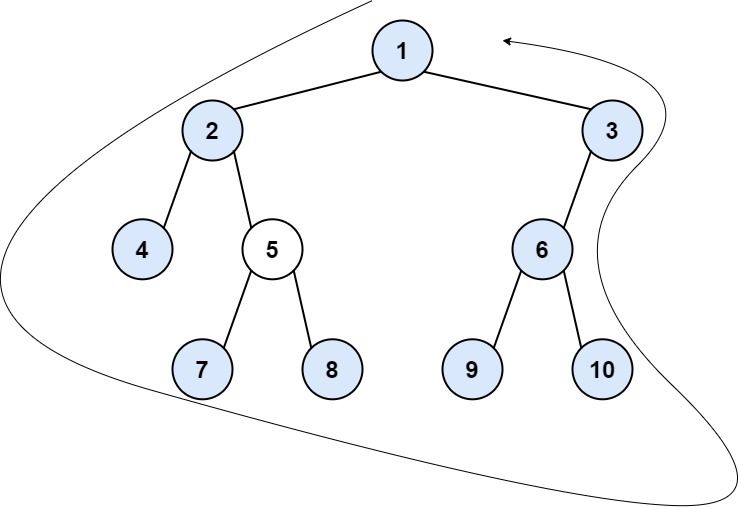The boundary of a binary tree is the concatenation of the root, the left boundary, the leaves ordered from left-to-right, and the reverse order of the right boundary.
The left boundary is the set of nodes defined by the following:
- The root node's left child is in the left boundary. If the root does not have a left child, then the left boundary is empty.
- If a node in the left boundary and has a left child, then the left child is in the left boundary.
- If a node is in the left boundary, has no left child, but has a right child, then the right child is in the left boundary.
- The leftmost leaf is not in the left boundary.
The right boundary is similar to the left boundary, except it is the right side of the root's right subtree. Again, the leaf is not part of the right boundary, and the right boundary is empty if the root does not have a right child.
The leaves are nodes that do not have any children. For this problem, the root is not a leaf.
Given the root of a binary tree, return the values of its boundary.
Example 1:
Input: root = [1,null,2,3,4] Output: [1,3,4,2] Explanation: - The left boundary is empty because the root does not have a left child. - The right boundary follows the path starting from the root's right child 2 -> 4. 4 is a leaf, so the right boundary is [2]. - The leaves from left to right are [3,4]. Concatenating everything results in [1] + [] + [3,4] + [2] = [1,3,4,2].
Example 2:
Input: root = [1,2,3,4,5,6,null,null,null,7,8,9,10] Output: [1,2,4,7,8,9,10,6,3] Explanation: - The left boundary follows the path starting from the root's left child 2 -> 4. 4 is a leaf, so the left boundary is [2]. - The right boundary follows the path starting from the root's right child 3 -> 6 -> 10. 10 is a leaf, so the right boundary is [3,6], and in reverse order is [6,3]. - The leaves from left to right are [4,7,8,9,10]. Concatenating everything results in [1] + [2] + [4,7,8,9,10] + [6,3] = [1,2,4,7,8,9,10,6,3].
Constraints:
- The number of nodes in the tree is in the range
[1, 104]. -1000 <= Node.val <= 1000
# Definition for a binary tree node.
# class TreeNode:
# def __init__(self, val=0, left=None, right=None):
# self.val = val
# self.left = left
# self.right = right
class Solution:
def boundaryOfBinaryTree(self, root: TreeNode) -> List[int]:
self.res = []
if not root:
return self.res
# root
if not self.is_leaf(root):
self.res.append(root.val)
# left boundary
t = root.left
while t:
if not self.is_leaf(t):
self.res.append(t.val)
t = t.left if t.left else t.right
# leaves
self.add_leaves(root)
# right boundary(reverse order)
s = []
t = root.right
while t:
if not self.is_leaf(t):
s.append(t.val)
t = t.right if t.right else t.left
while s:
self.res.append(s.pop())
# output
return self.res
def add_leaves(self, root):
if self.is_leaf(root):
self.res.append(root.val)
return
if root.left:
self.add_leaves(root.left)
if root.right:
self.add_leaves(root.right)
def is_leaf(self, node) -> bool:
return node and node.left is None and node.right is None/**
* Definition for a binary tree node.
* public class TreeNode {
* int val;
* TreeNode left;
* TreeNode right;
* TreeNode() {}
* TreeNode(int val) { this.val = val; }
* TreeNode(int val, TreeNode left, TreeNode right) {
* this.val = val;
* this.left = left;
* this.right = right;
* }
* }
*/
class Solution {
private List<Integer> res;
public List<Integer> boundaryOfBinaryTree(TreeNode root) {
if (root == null) {
return Collections.emptyList();
}
res = new ArrayList<>();
// root
if (!isLeaf(root)) {
res.add(root.val);
}
// left boundary
TreeNode t = root.left;
while (t != null) {
if (!isLeaf(t)) {
res.add(t.val);
}
t = t.left == null ? t.right : t.left;
}
// leaves
addLeaves(root);
// right boundary(reverse order)
Deque<Integer> s = new ArrayDeque<>();
t = root.right;
while (t != null) {
if (!isLeaf(t)) {
s.offer(t.val);
}
t = t.right == null ? t.left : t.right;
}
while (!s.isEmpty()) {
res.add(s.pollLast());
}
// output
return res;
}
private void addLeaves(TreeNode root) {
if (isLeaf(root)) {
res.add(root.val);
return;
}
if (root.left != null) {
addLeaves(root.left);
}
if (root.right != null) {
addLeaves(root.right);
}
}
private boolean isLeaf(TreeNode node) {
return node != null && node.left == null && node.right == null;
}
}/**
* Definition for a binary tree node.
* function TreeNode(val, left, right) {
* this.val = (val===undefined ? 0 : val)
* this.left = (left===undefined ? null : left)
* this.right = (right===undefined ? null : right)
* }
*/
/**
* @param {TreeNode} root
* @return {number[]}
*/
var boundaryOfBinaryTree = function (root) {
let leftBoundary = function (root, res) {
while (root) {
let curVal = root.val;
if (root.left) {
root = root.left;
} else if (root.right) {
root = root.right;
} else {
break;
}
res.push(curVal);
}
};
let rightBoundary = function (root, res) {
let stk = [];
while (root) {
let curVal = root.val;
if (root.right) {
root = root.right;
} else if (root.left) {
root = root.left;
} else {
break;
}
stk.push(curVal);
}
let len = stk.length;
for (let i = 0; i < len; i++) {
res.push(stk.pop());
}
};
let levelBoundary = function (root, res) {
if (root) {
levelBoundary(root.left, res);
if (!root.left && !root.right) {
res.push(root.val);
}
levelBoundary(root.right, res);
}
};
let res = [];
if (root) {
res.push(root.val);
leftBoundary(root.left, res);
if (root.left || root.right) {
levelBoundary(root, res);
}
rightBoundary(root.right, res);
}
return res;
};
